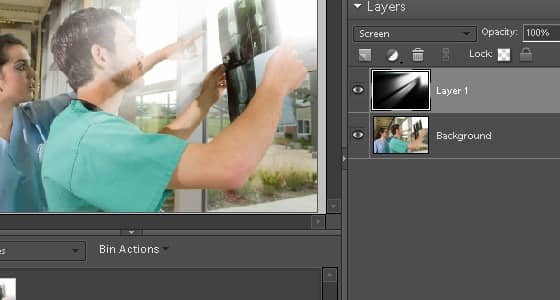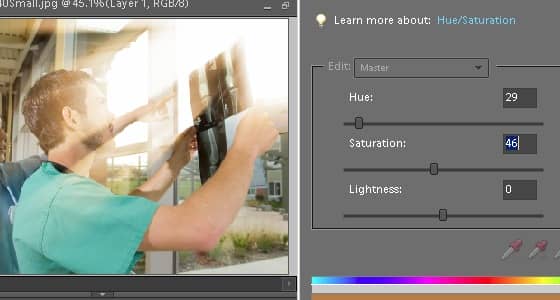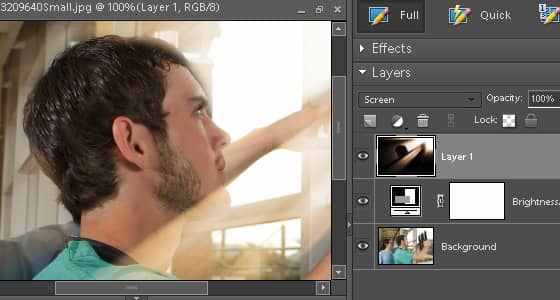Turn any photo into a dot grid artwork with these Photoshop actions. You'll get great results with dots that change size. They get larger in brighter areas and smaller in darker areas. Free download available.

Step 9: Tint the light
With the top layer selected, choose Enhance > Adjust Color > Adjust Hue/Saturation. Inside the Hue/Saturation tool, checkmark the Colorize option near the bottom right. Then, adjust the hue and saturation setting to tint the ray of light. For an warm tint, use the settings from the image below.

Step 10: Adjust the brightness and contrast
Select the Background layer then choose Layer > New Adjustment Layer > Brightness/Contrast. This will create a new Brightness/Contrast adjustment layer positioned above the Background layer so that it is only affecting the Background layer and not the ray of light. Adjust the settings to get the results that you like. Below are three example settings you can use.

Step 11: Selectively erase areas in the light
Sometimes the ray of light can get in the way of important areas such as the face. If you want to erase the ray of light from any area, select the top layer then select the brush tool with a black foreground color and paint over the areas.

Final Results



2 comments on “Ray of Light”
Your technique made a vast difference in my book cover. I needed some visual impact and I added a strong light source using your technique. Now the image has come to life. Thank you!
Re your technique - vs your graphic. I assume you allowed the contrasts to stay the way they are, for the 'visual,' aspect of a newbie, to see. But in terms of the light source, the 'ray tracing,' the shadow on the woman behind, It does not look realistic, and the color variations, on the woman are strange,
If there is dust in the air, the rays might look as clean of edges as yours do. But the pic is very clear, and LIGHT IS INVISIBLE, UNTIL IT COMES IN CONTACT WITH AN OBJECT TO REFLECT OFF OF. In this case, it would be dust in the air..
There is a very nice and FREE little Photoshop plugin, called 'Luce.' At first, I did not get it, but I found ways to create some wonderful images. I did not use it as simple pre-set tool, but made layers, and reversed some of the EFx. Check it out. Here is another method, you might like.
Go on top of whatever image you need the ray, go to the 'Shape' tools, and use a rectangle, or whatever. Make sure the 'COLOR' of the RAY you need, is already in the color palette. If you need the light to expand, such as a SPOTLIGHT on a STAGE,, create the rectangle between the two objects; i.e. the light source, and its destination.. Make it smaller than the finished area. Go to the 'DIRECT SELECTION TOOL, and grab the corners, and pull the shape to what shape your ray is to be. If you need additional tools to pull, or push the shape, go to the 'Add Anchor Point tool, and put in the 'dots' where you need. When the shape is good, go to the 'Gaussian' Blur Filter, and watch a wonderful transformation. AFTER that, you can go to (immediate go, or the menu won't be there as you need) Edit menu, 'Fade Gaussian' Blur, and you''ll get lost in the possibilities. "Also, you can go it it's layer, control it's opacity, and also use the 'move tool, to make it a different scale, or size etc..